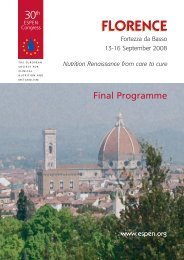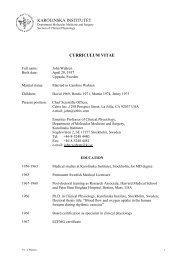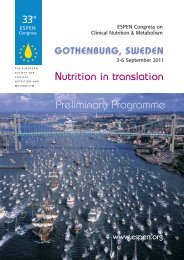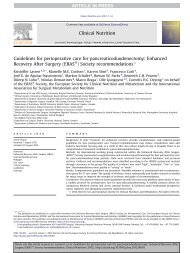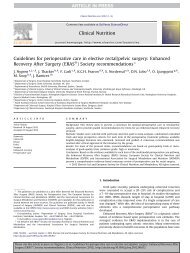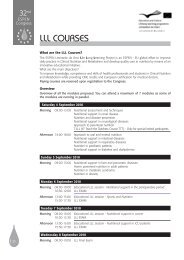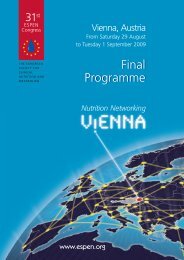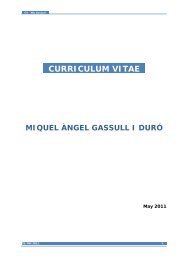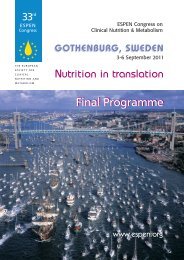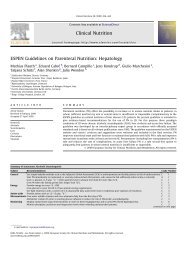Bioelectrical impedance analysisFpart I: review of principles ... - espen
Bioelectrical impedance analysisFpart I: review of principles ... - espen
Bioelectrical impedance analysisFpart I: review of principles ... - espen
You also want an ePaper? Increase the reach of your titles
YUMPU automatically turns print PDFs into web optimized ePapers that Google loves.
diuretic therapy with proximally placed detector<br />
electrodes (elbow and knee). Scharfetter et al. 59<br />
estimated that, due to electrolyte changes, at the<br />
end <strong>of</strong> dialysis, the error with respect to the<br />
volume change was large (p15% for the ECW and<br />
420% for ICW). They concluded that a correction <strong>of</strong><br />
the fluid distribution model for resistivity changes<br />
is necessary to obtain more reliable ICW data. The<br />
potential <strong>of</strong> BIS can only be exhausted if the data<br />
are interpreted with adequate algorithm that<br />
include reliable data fitting and a valid fluid<br />
distribution model which considers tissue nonhomogeneities.<br />
37 A valid model must guarantee<br />
that ECW changes do not corrupt the ICW and vice<br />
versa. 37 Standardization <strong>of</strong> BIS method remains a<br />
concern.<br />
The meta-analysis by Martinoli et al. 60 concluded<br />
that SF-BIA and BIS significantly overestimated TBW<br />
in healthy individuals, whereas there was no<br />
overestimation by MF-BIA. MF-BIA seems to be a<br />
more accurate method for determining the TBW<br />
compartment for healthy and obese adults and for<br />
persons with chronic renal failure.<br />
Body cell mass (BCM)<br />
Whereas FFM is everything that is not body fat,<br />
there is no consensus on the physiological meaning<br />
<strong>of</strong> measures <strong>of</strong> ‘‘cellular mass’’, ‘‘BCM’’ or ‘‘metabolically<br />
active tissue’’ and ‘‘ICW’’. The BCM is the<br />
protein rich compartment which is affected in<br />
catabolic states, and loss <strong>of</strong> BCM is associated with<br />
poor clinical outcome. 61,62 In overhydrated patients,<br />
even precise determination <strong>of</strong> FFM might<br />
fail to detect relevant protein malnutrition because<br />
<strong>of</strong> expansion <strong>of</strong> the ECW. Estimating the size is<br />
difficult because it is a complex compartment,<br />
comprising all nonadipose cells as well as the<br />
aqueous compartment <strong>of</strong> adipocytes. Future research<br />
is needed to define BCM and the role <strong>of</strong> BIA<br />
in its clinical evaluation.<br />
In patients with severe fluid overload, such as<br />
patients with ascites, inter-individual differences<br />
<strong>of</strong> lean tissue hydration are probably too high to<br />
develop uniform equations to assess BCM. Pirlich<br />
et al. 63 concluded that in patients with large<br />
alterations <strong>of</strong> body geometry or hydration status<br />
the application <strong>of</strong> standard BIA is not appropriate<br />
to assess BCM.<br />
Ward and Heitmann 64 evaluated assessment <strong>of</strong><br />
BCM and ECW by BIA without the need for<br />
measurement <strong>of</strong> height and found that the significant<br />
differences in the mean values and wide<br />
limits <strong>of</strong> agreement compared to reference data for<br />
BCM and ECW do not permit to predict these body<br />
ARTICLE IN PRESS<br />
1232 U.G. Kyle et al.<br />
compartments without inclusion <strong>of</strong> height in spite<br />
<strong>of</strong> obvious advantages <strong>of</strong> not requiring an accurate<br />
measurement <strong>of</strong> height.<br />
BIA measurements and equations<br />
BIA measurements must be standardized in order to<br />
obtain reproducible results (see BIAFpart 2).<br />
Reported mean coefficients <strong>of</strong> variation for within-day<br />
R measurements are E1–2%; daily or weekly<br />
intra-individual variability is slightly larger ranging<br />
from E2% to 3.5%. 65–68 Day-to-day coefficients <strong>of</strong><br />
variation increases for frequencies lower than<br />
50 kHz. 69 Overall reproducibility/precision is 2.7–<br />
4.0%. 67 Prediction errors were estimated to be 3–8%<br />
for TBW and 3.5–6% for FFM, respectively. 70,71<br />
Early BIA equations were validated in inadequate<br />
populations, as demonstrated in respiratory insufficiency<br />
patients. 72 Large variations in results were<br />
noted with many formulas published in the literature<br />
that precluded clinical interpretation. The use<br />
<strong>of</strong> ‘‘general’’ prediction equations across different<br />
age and ethnic groups without prior testing <strong>of</strong> their<br />
validity should be avoided. Choosing a BIA equation<br />
that is adapted to the populations studied continues<br />
to be a limiting factor <strong>of</strong> BIA.<br />
Standardization <strong>of</strong> future studies with regard to<br />
methodological considerations (such as inclusion<br />
and exclusion criteria, standardization <strong>of</strong> BIA<br />
methods etc.) as discussed by Gonzalez et al. 73<br />
should help to improve BIA results in the future.<br />
Table <strong>of</strong> validated equations<br />
Selected BIA equations published since l990 for<br />
adults for FFM (Table 1); 6,58,70,74–88 body fat (Table<br />
2), 38,82,86,88,89 TBW (Table 3), 20,25,32,58,65,70,78,88,90–94<br />
ECW (Table 4), 20,25,32,90,92,93,95 ICW (Table 5) 96,97 and<br />
BCM (Table 6) 58,98 are shown in order <strong>of</strong> increasing<br />
standard error <strong>of</strong> the estimate (SEE). They are<br />
limited to studies in healthy subjects that include at<br />
least 40 subjects and are validated against a<br />
criterion measure. For discussion <strong>of</strong> BIA equations<br />
in specific diseases, we refer the reader to<br />
‘‘<strong>Bioelectrical</strong> <strong>impedance</strong> <strong>analysisFpart</strong> II: utilization<br />
in clinical practice’’. The equation for TBW by<br />
Kushner and Schoeller 65 is included because it is<br />
frequently cited in the literature. For BIA equations<br />
for FFM, TBW and body fat published prior to l990,<br />
we refer the reader to Houtkooper et al. 99<br />
How to choose a BIA equation<br />
Houtkouper et al. 99 suggested that prediction error<br />
(SEE) <strong>of</strong> 2.0–2.5 kg in men and 1.5–1.8 kg in women



